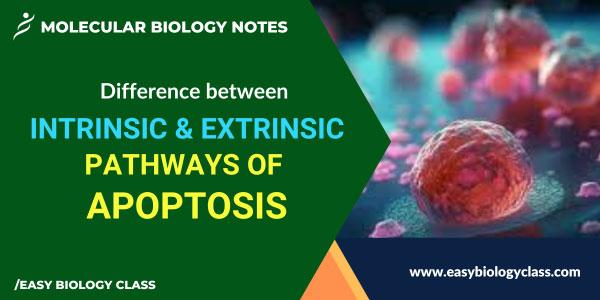The intrinsic and extrinsic pathways are two mechanisms of apoptosis or programmed cell death. This classification is based on the source of stimuli that induces the apoptotic cell death.
Intrinsic Pathway: This pathway is initiated within the cell due to internal stress, such as DNA damage or cellular damage. It involves the release of pro-apoptotic proteins from the mitochondria, leading to the activation of caspase enzymes and cell death.
Extrinsic Pathway: This pathway is triggered externally by extracellular signals, like death ligands binding to death receptors on the cell surface. It activates caspases directly, ultimately resulting in apoptosis.
Both pathways converge to execute apoptosis, maintaining tissue homeostasis and eliminating damaged or unwanted cells. The present post discusses the Similarities and Difference between Intrinsic and Extrinsic Pathways of Apoptosis.
Molecular Biology Notes | Molecular Biology PPTs | Molecular Biology MCQs
Difference between Intrinsic and Extrinsic Pathway of Apoptosis
Characteristic Intrinsic Pathway Extrinsic Pathway
Triggered by Triggered by internal cellular stressors, such as DNA damage, ER stress, or loss of growth factors. Triggered by external signals, such as binding of death ligands (e.g., Fas ligand) to death receptors on the cell surface.
Key Regulators Bcl-2 family proteins, including anti-apoptotic (e.g., Bcl-2) and pro-apoptotic (e.g., Bax) members. Death receptors (e.g., Fas, TNF receptor) and associated adapter proteins (e.g., FADD).
Mitochondrial Role Mitochondria play a central role; release of cytochrome c from mitochondria triggers caspase activation. Mitochondria are not directly involved; signalling occurs through death receptor activation.
Cytochrome c Release Cytochrome-c is released from mitochondria into the cytoplasm, initiating the formation of apoptosome and caspase activation. Cytochrome-c release does not occur; activation of caspases is initiated through the death receptor signalling complex.
Bcl-2 Family Proteins Bcl-2 family proteins regulate mitochondrial permeability and apoptosis sensitivity. Bcl-2 family proteins do not play a major role in the extrinsic pathway.
Caspase Activation Caspase-9 is the initiatory caspase which is activated by the apoptosome complex, initiating the caspase cascade. Caspase-8 is the initiator caspase which is activated at the death-inducing signalling complex (DISC), leading to caspase cascade activation.
Pathway Regulation Regulated by cellular stress, DNA damage response, and the balance of Bcl-2 family proteins. Regulated by external ligand-receptor interactions and the formation of the DISC.
Cellular Responses Responds to internal cellular damage, DNA mutations, and cellular stress. Responds to external signals, immune responses, and viral infections.
Examples of Stimuli DNA damage, chemotherapeutic agents, nutrient deprivation. Radiation, binding of Fas ligand, TNF-related apoptosis-inducing ligand (TRAIL), or other death ligands to death receptors.
Execution Phase Proceeds to the execution phase through caspase activation and mitochondrial outer membrane permeabilization. Proceeds to the execution phase through activation of downstream caspases, bypassing mitochondrial involvement.
Biological Significance Eliminates cells with significant internal damage to prevent potential harm to the organism. Regulates immune responses, eliminates virus-infected or potentially harmful cells, and is involved in tissue development.
Examples of Diseases Dysregulation of the intrinsic pathway is associated with cancer and neurodegenerative diseases. Defects in the extrinsic pathway can lead to autoimmune diseases and impaired immune responses.
Both the intrinsic and extrinsic pathways of apoptosis play critical roles in maintaining cellular homeostasis, eliminating damaged or potentially harmful cells, and regulating immune responses. The pathways are distinct in terms of their triggers, regulators, mechanisms, and biological significance.
Similarities between Intrinsic and Extrinsic Pathway of Apoptosis
Ø Regardless of the initiating signal, both pathways ultimately lead to cell death and the dismantling of the cell’s components.
Ø Both pathways converge on the activation of caspase enzymes, which are responsible for executing the cell death process.
Ø Both pathways are tightly regulated to ensure that apoptosis occurs only when necessary, preventing excessive cell death.
Ø Both are part of the broader cellular signalling network that helps maintain tissue homeostasis and eliminate damaged or unwanted cells.
<<< Back to Molecular Biology Notes
You may also like NOTES in...
BOTANY BIOCHEMISTRY MOL. BIOLOGY
ZOOLOGY MICROBIOLOGY BIOSTATISTICS
ECOLOGY IMMUNOLOGY BIOTECHNOLOGY
GENETICS EMBRYOLOGY PHYSIOLOGY
EVOLUTION BIOPHYSICS BIOINFORMATICS
You may also like...
NOTES QUESTION BANK COMPETITIVE EXAMS.
PPTs UNIVERSITY EXAMS DIFFERENCE BETWEEN..
MCQs PLUS ONE BIOLOGY NEWS & JOBS
MOCK TESTS PLUS TWO BIOLOGY PRACTICAL

